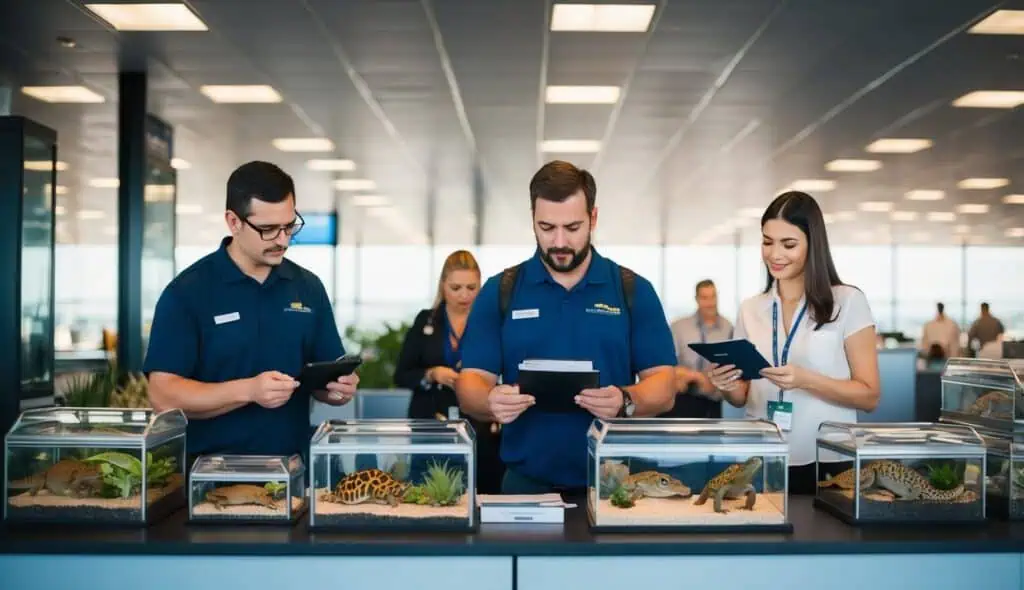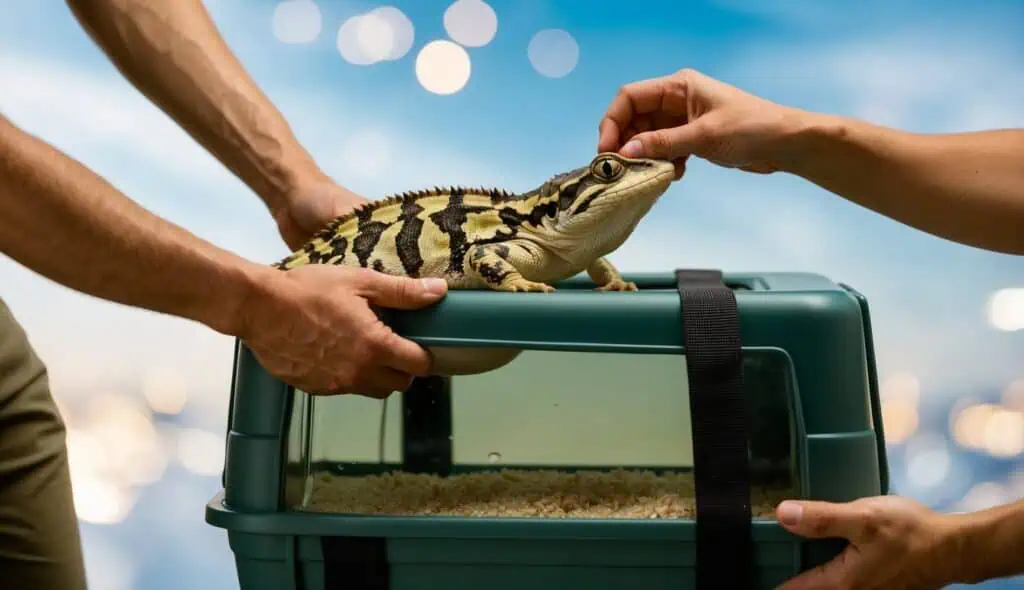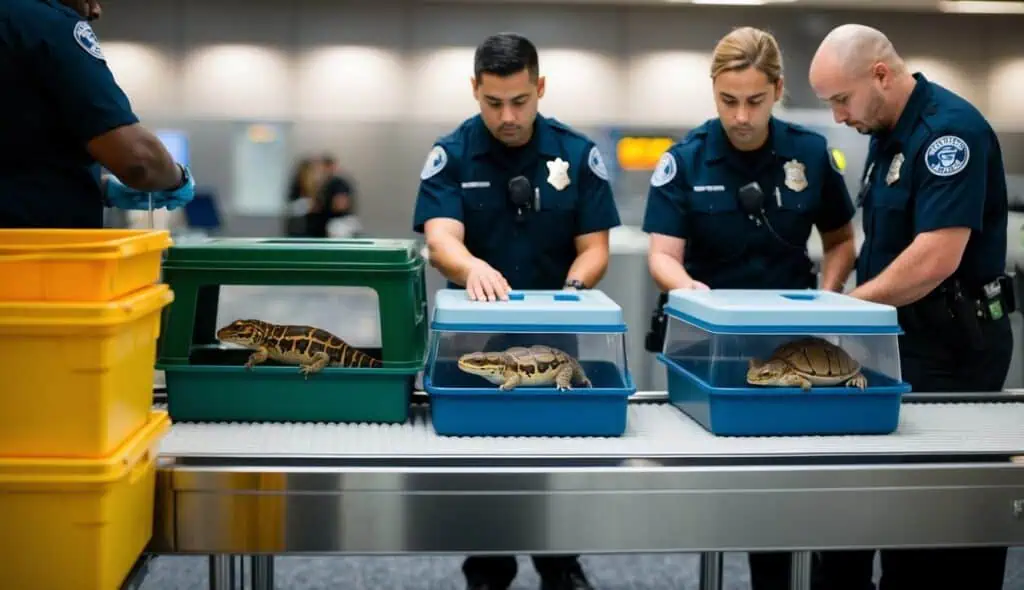Traveling with reptiles and amphibians can be tricky. Many airlines have strict rules about these pets. Some allow them, while others don’t. It’s important to know the policies before you book your flight.

Airlines that let reptiles fly include American Airlines, Air Europa, and a few others.
These airlines often require reptiles to travel in the cargo hold. They may have limits on the size and number of animals you can bring. Fees for flying with reptiles can range from $45 to $190, depending on the airline and if you’re going overseas.
Before you pack your scaly friend, check the rules for your destination too. Some states and countries don’t allow certain reptiles or amphibians. Make sure you have a proper travel container that meets airline standards. This will help keep your pet safe and comfortable during the trip.
Contents
Understanding Airline Restrictions

Airlines have specific rules for traveling with reptiles and amphibians. These policies cover general pet guidelines and special considerations for cold-blooded animals.
General Airline Pet Policies
Most airlines allow pets on board, but rules vary. Some let small animals in the cabin, while others require pets to travel as cargo. Size and weight limits apply to pet carriers. You’ll need to book pet travel in advance.
Airlines often charge extra fees for pets. Prices range from $50 to $200 or more. You must use an approved carrier that fits under the seat or in the cargo hold.
Health certificates are usually needed for pets. Get these from a vet within 10 days of your flight. Some airlines limit the number of pets per flight, so book early.
Specific Reptile and Amphibian Considerations
Reptiles and amphibians face extra rules when flying. Many airlines only allow them in the cargo hold. This is because they need special care and can be dangerous.
Temperature is crucial for these pets. Cargo areas must stay between 45°F and 85°F for safe travel. Some airlines won’t fly reptiles in very hot or cold months.
You need a secure, escape-proof container for your pet. It should have air holes and be labeled with “Live Animal” stickers. Include a water dish that won’t spill during the flight.
Snakes are often not allowed on planes at all. Lizards and turtles are more commonly accepted. Check each airline’s policy, as they differ widely for these animals.
Preparing Your Reptile or Amphibian for Travel

Getting your scaly or slimy friend ready for a trip takes some planning. You’ll need to focus on their health and safety, as well as picking the right carrier. Here’s what you need to know:
Health and Safety Requirements
Before traveling, take your pet to the vet for a check-up. Make sure all vaccines are up to date. Get a health certificate, which many airlines require. This document proves your animal is fit to fly.
Pack any medicines your pet needs. Bring enough food and water for the journey. For amphibians, you might need to mist them during the trip to keep their skin moist.
Think about temperature control. Reptiles and amphibians can’t regulate their body heat well. Use hot or cold packs in the carrier to keep them comfy.
Carrier Specifications
Choose a carrier that fits your pet well. It should be big enough for them to turn around, but not so large they slide around.
Make sure the carrier is escape-proof. Reptiles are skilled at finding ways out. Use a secure lock if needed.
Add bedding to make the trip comfy. For snakes, use paper towels or newspaper. For lizards, a soft cloth works well.
Label the carrier clearly with your contact info and “Live Animal” warnings. This helps airline staff handle it carefully.
Check airline rules on carrier size and materials. Some require hard-sided containers for cargo travel.

Going through airport security with reptiles or amphibians requires careful planning. You’ll need to follow specific rules and take extra steps to keep your pets safe and comfortable.
TSA Guidelines for Pets
When traveling with reptiles or amphibians, you must remove them from their carriers for screening. Place small animals in a clear, plastic container to go through the X-ray machine. Larger pets will need a special inspection by TSA officers.
Make sure to tell the security staff about your pet before screening starts. They may ask you to hold your animal while they check its carrier. Keep your pet’s documents handy, like health certificates or permits.
TSA allows most reptiles and amphibians through checkpoints. But some airlines have their own rules about which species they accept. Always check with your airline before booking a flight with your scaly or slimy friend.
International Travel Considerations
Flying internationally with reptiles or amphibians is more complex. You’ll face extra rules and paperwork. Many countries have strict import laws for exotic pets. Some even ban certain species completely.
Before your trip, research the pet entry requirements for your destination. You may need:
- Health certificates
- Import permits
- Quarantine periods
Some nations require pets to enter through specific airports. Others might ask for advance notice of your arrival with an animal.
Remember, rules can change. Double-check all requirements close to your travel date. Give yourself plenty of time to get the right documents. This will help avoid issues at foreign customs checkpoints.
In-Flight Care for Your Pet
Proper care during the flight is crucial for your reptile or amphibian’s health and comfort. Focus on keeping their environment stable and meeting their basic needs.
Temperature and Pressure Conditions
Reptiles and amphibians are sensitive to temperature changes. Pack heat or cool packs to regulate their carrier’s temperature. Wrap these in cloth to prevent direct contact with your pet.
Check the weather at your departure and arrival cities. Adjust your pet’s carrier setup based on expected temperatures.
Air pressure changes can affect your pet. Ask the airline staff to keep your pet’s carrier in a pressurized area of the cargo hold.
Feeding and Hydration Needs
Don’t feed your reptile or amphibian right before the flight. This can cause digestive issues during travel. Instead, feed them a small meal 24 hours before departure.
Provide water in a spill-proof container. Use a water gel or sponge to prevent spills. This ensures your pet stays hydrated without making a mess.
For longer flights, pack small amounts of food. You can offer this during layovers if needed.
Remember, stress can affect your pet’s appetite. Don’t worry if they eat less than usual during travel.
Selecting a Reptile-Friendly Airline
Not all airlines allow reptiles on board. You need to pick an airline that welcomes your scaly friend. Check their rules before booking your flight.
Comparing Policies and Services
Look at different airlines’ pet policies. Some let reptiles fly in the cabin, while others only allow them in cargo.
- Aegean Airlines: permits up to 5 lizards for flights under 3 hours.
- Air Canada, and Alaska Air: accept reptiles in cargo.
- American Airlines: Does not accept reptiles in the cabin or as checked baggage.
- Delta Air Lines: Reptiles are not allowed in the cabin; certain reptiles may be shipped via Delta Cargo.
- United Airlines: Reptiles are prohibited in the cabin and as checked baggage but may be transported through United Cargo under specific conditions.
Check size and weight limits for pet carriers. Aegean’s max size is 60 cm x 45 cm x 40 cm, with a 13 lb weight limit.
Consider fees too. In-cabin fees range from $50 to $200. Cargo fees are often higher and based on container size.
Airline Certification and Accreditations
Choose airlines with good pet transport records. Look for certifications from animal welfare groups. These show the airline takes proper care of animals.
Some airlines have special pet programs. These may offer extra services or care for your reptile.
Ask about staff training for handling reptiles. Trained staff can better care for your pet during the trip.
Check if the airline follows IATA Live Animals Regulations. This ensures they meet international standards for animal transport.
Legal and Documentation Requirements
Traveling with reptiles and amphibians requires specific paperwork and permits. You need to follow strict rules to ensure your pet can legally enter your destination.
CITES and Other Regulations
The Convention on International Trade in Endangered Species (CITES) protects many reptile and amphibian species. You must check if your pet is on the CITES list. If it is, you’ll need a special permit to travel across borders.
Some countries have their own rules. For example, the U.S. bans certain species. You should contact the embassy of your destination country to learn their rules.
Always carry proof of your pet’s origin. This can be a receipt or breeder’s certificate.
Health Certificates and Veterinary Records
Most airlines and countries need a health certificate for your reptile or amphibian. This document proves your pet is healthy and fit to travel.
Get the certificate from a licensed vet within 10 days of your trip. It should state:
- Your pet’s species
- Any unique markings
- Vaccination history
- Overall health status
Keep a copy of your pet’s medical records. This includes past treatments and checkups. Some places may ask for these.
Remember, rules can change. Double-check requirements close to your travel date.
Arrival and Post-Flight Procedures
After landing, you’ll need to follow important steps to ensure a smooth transition for your reptile or amphibian pet. These include going through customs and helping your pet adjust to its new surroundings.
Customs and Quarantine
When you arrive at your destination, head to the customs area. Have your pet’s documents ready, including health certificates and import permits. Some countries may require a quarantine period for reptiles and amphibians.
Be prepared to answer questions about your pet. Customs officers might check your pet’s container and health status. Follow their instructions carefully.
In some cases, your pet may need to stay in a quarantine facility. This can last from a few days to several weeks. Make sure you know the rules beforehand to avoid surprises.
Acclimating Your Pet to the New Environment
Once cleared, focus on helping your pet adjust. Keep it in its travel container until you reach your final destination. This helps reduce stress.
Set up a temporary habitat with familiar items from home. Gradually introduce your pet to its new space. Monitor temperature and humidity closely, as these may differ from your home climate.
Offer food and water, but don’t be alarmed if your pet doesn’t eat right away. Travel can be stressful, and it may take time for your pet to feel comfortable. Watch for signs of illness or unusual behavior in the days following travel.
Frequently Asked Questions
Flying with reptiles and amphibians can be tricky. Here are some common questions about airline policies and what you need to know.
What are the general airline policies for traveling with reptiles and amphibians?
Most airlines don’t allow reptiles or amphibians in the cabin. They must travel in the cargo hold. You need a proper carrier that meets airline size rules. Make sure it’s escape-proof and has air holes.
Some airlines ban reptiles completely. Check the rules before you book. Policies can change, so call the airline to confirm.
Which airlines permit reptiles and amphibians in the cabin, and what are their specific requirements?
Very few airlines let reptiles in the cabin. Aegean Airlines allows up to 5 lizards for flights under 3 hours. The carrier must fit under the seat and can’t be bigger than 60 cm x 45 cm x 40 cm.
Other airlines like Air Canada and Alaska Air only allow reptiles in cargo. Always check current policies, as they may change.
How do international airline policies differ from domestic ones regarding the transport of reptiles and amphibians?
International flights often have stricter rules for reptiles. Some countries ban certain species. You may need special permits or health certificates.
Domestic flights in the U.S. are usually easier. But policies vary by airline. Some allow reptiles in cargo, while others don’t accept them at all.
Are there any special considerations for flying with bearded dragons as pet companions?
Bearded dragons must travel in a secure, ventilated carrier. The carrier should be small enough to fit under a seat if allowed in the cabin.
Keep your dragon warm during the trip. Use heat packs if needed. Don’t feed them right before the flight to avoid mess.
What documentation and health certifications are required when flying with pet reptiles?
You’ll need a health certificate from a vet. This proves your pet is healthy and fit to fly. Get it within 10 days of your trip.
Some airlines ask for proof of ownership. International trips may require extra paperwork, like import permits or vaccination records.
What items and preparations are necessary when transporting reptiles and amphibians via air?
Pack a secure, airline-approved carrier. Include a water dish that won’t spill. Bring heat or cold packs to keep the right temperature.
Label the carrier with your contact info and care instructions. Pack food and supplies in your checked bag. Arrive early to handle any extra paperwork.

I have been traveling around the world by air since the early 70s and living overseas too. I worked for British Airways for a number of years and I am also a private pilot. About Me


